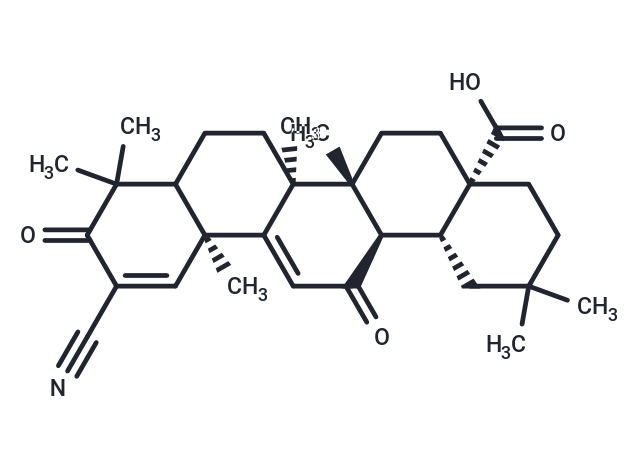- Remove All
 Your shopping cart is currently empty
Your shopping cart is currently empty
Bardoxolone
Bardoxolone (CDDO) is a synthetic oleanane triterpenoid that blocks the cellular synthesis of inducible nitric oxide synthase and inducible COX-2 in INF-γ-activated mouse macrophages with an IC50 value of 0.4 nM. By suppressing reactive oxygen and nitrogen species (ROS/RNS) formation, it promotes the cellular control of ROS/RNS levels that would lead to DNA damage associated with tumorigenesis. In various Y cell lines, Bardoxolone has been shown to specifically inhibit proliferation and induce apoptosis. Mechanism studies revealed that Bardoxolone is a ligand for peroxisome proliferator-activated receptor γ, and also that it induces genes regulated by Nrf2, including heme oxygenase-1 and eotaxin-1, which play a role in antioxidant response element signaling activity.

Bardoxolone
| Pack Size | Price | Availability | Quantity |
|---|---|---|---|
| 5 mg | $68 | In Stock | |
| 10 mg | $93 | In Stock | |
| 25 mg | $112 | In Stock | |
| 50 mg | $134 | In Stock | |
| 100 mg | $247 | In Stock | |
| 1 mL x 10 mM (in DMSO) | $74 | In Stock |
Product Introduction
| Description | Bardoxolone (CDDO) is a synthetic oleanane triterpenoid that blocks the cellular synthesis of inducible nitric oxide synthase and inducible COX-2 in INF-γ-activated mouse macrophages with an IC50 value of 0.4 nM. By suppressing reactive oxygen and nitrogen species (ROS/RNS) formation, it promotes the cellular control of ROS/RNS levels that would lead to DNA damage associated with tumorigenesis. In various Y cell lines, Bardoxolone has been shown to specifically inhibit proliferation and induce apoptosis. Mechanism studies revealed that Bardoxolone is a ligand for peroxisome proliferator-activated receptor γ, and also that it induces genes regulated by Nrf2, including heme oxygenase-1 and eotaxin-1, which play a role in antioxidant response element signaling activity. |
| In vitro | Bardoxolone methyl is a novel synthetic triterpenoid and antioxidant inflammation modulator that potently induces Nrf2 and inhibits NF-κB and Janus-activated kinase/STAT signaling. Bardoxolone methyl has been shown to induce differentiation, inhibit proliferation, and induce apoptosis in cancer cell lines[2]. |
| In vivo | Kidney sections from monkeys treated with Bardoxolone methyl displayed a reduction in megalin protein expression, despite unchanged mRNA expression levels across all studied groups. Densitometry confirmed this reduction, indicating that Bardoxolone methyl significantly lowers megalin protein levels in the monkey kidney, without affecting cubilin protein or mRNA expression. Moreover, creatinine clearance in these monkeys significantly changed from the baseline and compared to vehicle-treated monkeys on day 28. Following 28 days of Bardoxolone methyl treatment, urinary albumin-to-creatinine ratios (UACRs) notably increased compared to vehicle-treated animals, with UACRs decreasing by 53.3% in vehicle-treated and increasing by 27.9% in Bardoxolone methyl-treated monkeys. In a separate study, male C57BL/6J mice were given Bardoxolone methyl orally during high-fat diet (HFD) feeding (HFD/BARD), with comparisons to mice solely on a high-fat (HFD) or a low-fat diet (LFD) for 21 weeks. HFD mice showed a significant increase in F4/80 crown-like structures by 95% and interstitial macrophages by 98% compared to LFD mice, both of which were substantially mitigated in HFD/BARD mice, showing reductions of 50% and 32% respectively, in these markers of inflammation. |
| Alias | RTA 401, CDDO |
| Molecular Weight | 491.66 |
| Formula | C31H41NO4 |
| Cas No. | 218600-44-3 |
| Smiles | CC1(C)CC[C@@]2(CC[C@]3(C)[C@@H]([C@H]2C1)C(=O)C=C1[C@@]2(C)C=C(C#N)C(=O)C(C)(C)C2CC[C@@]31C)C(O)=O |
| Relative Density. | 1.18 |
| Storage | Powder: -20°C for 3 years | In solvent: -80°C for 1 year | Shipping with blue ice. | |||||||||||||||||||||||||||||||||||
| Solubility Information | DMSO: 100 mg/mL (203.39 mM), Sonication is recommended. | |||||||||||||||||||||||||||||||||||
Solution Preparation Table | ||||||||||||||||||||||||||||||||||||
DMSO
| ||||||||||||||||||||||||||||||||||||
Calculator
In Vivo Formulation Calculator (Clear solution)
Dose Conversion
Tech Support

Copyright © 2015-2025 TargetMol Chemicals Inc. All Rights Reserved.



